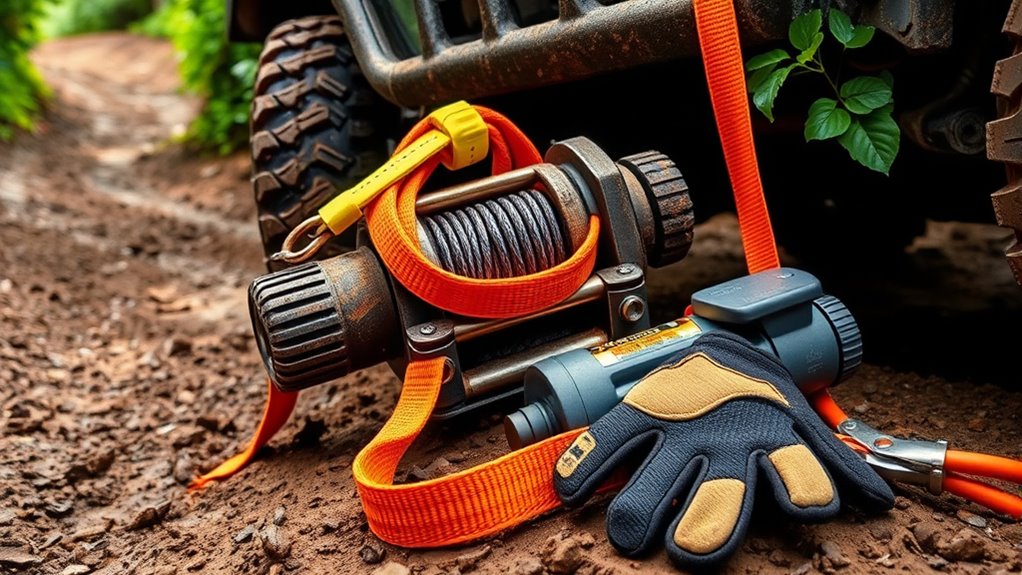To stay safe on tough trails, you need crucial off-road recovery gear like a tow strap rated for your vehicle’s weight, a reliable winch, shackles for secure connections, and a recovery jack. Always check your gear’s condition and stay aware of terrain challenges. Proper use of these tools prevents injuries and vehicle damage. Mastering these essentials ensures you’re ready for surprises, and there’s more important advice to help you stay safe on every adventure.
Key Takeaways
- Carry a rated tow strap, shackles, and a recovery jack tailored to your vehicle’s weight and terrain.
- Include a reliable winch for self-recovery, especially in remote or challenging off-road conditions.
- Perform regular vehicle maintenance—check tire pressure, fluid levels, and suspension—to prevent breakdowns.
- Follow safety guidelines: assess the situation, keep clear of recovery lines, and communicate clearly among team members.
- Prepare thoroughly by carrying essential tools and gear, and stay aware of terrain and vehicle condition during off-road trips.

Getting stuck off-road can happen to even the most experienced adventurers, but having the right recovery gear guarantees you’re prepared to get back on your wheels quickly and safely. Before hitting the trail, you should prioritize vehicle maintenance to ensure your vehicle is in top condition. Regularly check tire pressure, fluid levels, and the integrity of your suspension system. A well-maintained vehicle is less likely to break down or get stuck, which directly supports trail safety. Proper vehicle maintenance not only improves your chances of avoiding emergencies but also makes recovery easier if you do encounter trouble. When you’re out on rugged trails, being proactive about your vehicle’s condition helps prevent issues that could turn into dangerous situations.
Proper vehicle maintenance before off-road adventures reduces breakdowns and ensures safer, smoother recovery when needed.
Equipping yourself with essential recovery gear is equally important. Items like a solid tow strap, a winch, shackles, and a recovery jack are fundamental tools for safe trail recovery. A heavy-duty tow strap, rated for your vehicle’s weight, allows you to pull yourself out of mud or sand without risking damage to your vehicle or injury to yourself. A winch offers even more reliability, especially when you’re alone or in remote areas where assistance is scarce. Shackles ensure secure connections between recovery points, preventing accidents during pulls. A recovery jack helps reposition your vehicle or lift tires off difficult terrain, making it easier to change tires or free stuck wheels. Additionally, understanding the different types of terrain you may encounter can help you select the most appropriate recovery gear for each situation.
Safety should always be your top priority when recovering your vehicle. Before attempting any recovery, assess the situation carefully. Ensure everyone stays clear of the recovery line’s path, since sudden snaps can cause injury. Use gloves when handling straps and shackles to avoid rope burns or pinched fingers. Keep your communication clear with any companions, and never rush the process. Proper trail safety also involves understanding your limits and knowing when to call for professional help if the situation exceeds your capabilities.
Having the right recovery gear and practicing good trail safety habits can turn a potentially dangerous situation into a manageable one. Always carry your essential tools, stay aware of your vehicle’s condition, and respect the terrain. When you combine diligent vehicle maintenance with quality recovery gear and safety awareness, you’re better prepared to handle off-road surprises. This approach not only keeps you safe but also ensures you can get back on the trail quickly, minimizing downtime and avoiding unnecessary risks. Remember, preparation and knowledge are your best allies when exploring off-road terrains.
Frequently Asked Questions
How Do I Choose the Right Recovery Gear for My Vehicle?
When choosing recovery gear, you need to take into account your vehicle’s weight and the terrain type you’ll encounter. Opt for a winch with a capacity at least 1.5 times your vehicle’s weight for safety. For rugged terrains, add heavy-duty tow straps and shackles, while softer terrains may only require lighter gear. Always select quality equipment that matches your specific vehicle and trail conditions to ensure safe, effective recovery.
What Are the Common Mistakes to Avoid With Recovery Gear?
When using recovery gear, you should avoid common mistakes like improper gear storage, which can cause damage or accidents, and neglecting the user manual, leading to improper use. Always check your gear regularly, store it properly, and read the instructions carefully. By doing so, you guarantee your safety and equipment longevity, making off-road recovery safer and more effective. Don’t overlook these basics to prevent mishaps on your trail adventures.
How Often Should I Inspect and Maintain My Recovery Equipment?
You should inspect and maintain your recovery equipment regularly to guarantee safety. Follow a consistent maintenance schedule, ideally before each trip and after use. Use an inspection checklist to verify that all gear, like straps and shackles, is in good condition, free of wear or damage. Regular checks help prevent equipment failure, so stay diligent and keep your gear reliable for safe off-road adventures.
Can Recovery Gear Be Used for Other Outdoor Activities?
You might wonder if recovery gear can serve other outdoor activities. The good news is, many pieces are multi-purpose equipment, offering outdoor versatility beyond off-road recovery. For instance, tow straps and winches can help in camping or rescue situations. Keep in mind, though, always check the gear’s specifications to guarantee it’s suitable for different uses, and never compromise safety for versatility.
What Training Is Recommended for Safe Off-Road Recovery Procedures?
You should take proper training to assure safe off-road recovery procedures. This includes learning about vehicle dynamics to understand how your vehicle responds during recovery, reducing risks. Additionally, practicing emergency communication skills is essential to coordinate with others and call for help if needed. Professional courses teach you safe techniques and proper gear use, making your off-road adventures safer and more enjoyable.
Conclusion
Don’t let worries about cost hold you back—quality off-road recovery gear is an investment in your safety and confidence on tough trails. With the right essentials, you’ll be prepared for unexpected setbacks and can enjoy your adventures with peace of mind. Remember, it’s better to be safe and ready than stranded and stressed. Equip yourself today and hit the trails knowing you’ve got what it takes to recover safely and confidently.









